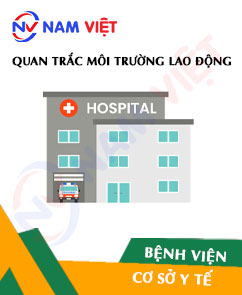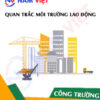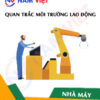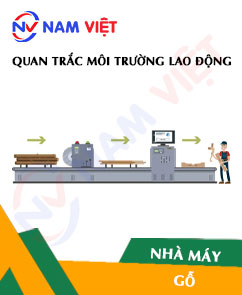Occupational environment monitoring in a hospital
99,000 ₫
Note: The above price is calculated for one sample, and the price may fluctuate depending on the area of the environment to be monitored and market movements. For more accurate pricing support, please refer to the price list or contact our consulting staff directly.
Monitoring the environment of a hospital is a session of collecting, analyzing, and evaluating factors at the workplace that may harm workers health.
Table of Contents
Toggle1. Overview of Hospitals
a. What is a hospital?
A hospital is a healthcare facility that provides care and treatment services to patients. It is a place where patients are admitted, diagnosed, and treated for illnesses and injuries. Hospitals typically have specialized departments and general clinics to meet the diverse healthcare needs of the community.
Hospitals may include departments and services such as outpatient clinics, inpatient wards, surgical units, emergency rooms, imaging departments, laboratories, treatment rooms, and inpatient accommodations. Doctors, nurses, medical staff, and support personnel work in hospitals to provide healthcare services to patients.
Hospitals play an important role in a country’s healthcare system. They contribute to disease diagnosis, treatment, prevention, and medical research. Hospitals may operate under public or private management, aiming to provide quality healthcare services and meet community needs.

b. Jobs inside hospitals and healthcare facilities
Within hospitals and healthcare facilities, there are many different jobs and roles. Here are some common positions in a hospital or healthcare facility:
- Doctor: Doctors are highly trained medical professionals responsible for diagnosing, treating, and managing patients. They may specialize in fields such as internal medicine, surgery, obstetrics and gynecology, cardiology, respiratory medicine, dermatology, and many others.
- Nurse: Nurses play a crucial role in direct patient care. They assist doctors during treatment, perform medical procedures, monitor vital signs, ensure hygiene, and provide personal care for patients.
- Medical staff: In addition to doctors and nurses, hospitals have various other medical staff such as nurse practitioners, laboratory technicians, imaging technicians, physiotherapists, and pharmacy personnel. These staff members perform specialized tasks to support patient diagnosis and treatment.
- Healthcare management: Healthcare management professionals, such as hospital directors, medical managers, and pharmaceutical managers, oversee general management in hospitals. They manage finances, resources, policies, and procedures to ensure smooth operations and quality healthcare services.
- Consultants and psychologists: Consultants and psychologists provide psychological support for patients and their families. They help address psychological and social aspects of patient care, reduce stress, and enhance coping with illnesses.

c. Types of machinery used in hospitals
Hospitals use various medical machines and equipment to assist in diagnosing, treating, and caring for patients. Some common machines in hospitals include:
- X-ray machine: Used to generate images of internal organs and structures to help doctors diagnose and monitor medical conditions.
- Ultrasound machine: Uses ultrasound waves to create images, allowing doctors to examine internal organs, blood vessels, and soft tissues. It is also used for fetal monitoring and cardiology diagnostics.
- MRI (Magnetic Resonance Imaging): Uses magnetic fields and radio waves to produce detailed images of the body, useful for diagnosing and monitoring conditions such as brain injuries, cardiovascular disease, and cancer.
- EKG (Electrocardiogram): Records the heart’s electrical activity to assess cardiac health and detect issues such as irregular heartbeats or arrhythmias.
- Respirator: Supports patients with breathing problems by maintaining airflow to the lungs and providing oxygen.
- Blood pressure monitor: Measures and records blood pressure to help doctors evaluate cardiovascular health and manage patients’ blood pressure conditions.
- Suction machine: Used to remove fluids during surgery or in cases of fluid accumulation in organs.

d. Occupational diseases for hospital workers
Workers in hospitals may develop the following occupational diseases:
- Infection-related diseases: Medical staff are at risk of exposure to infectious agents such as bacteria, viruses, fungi, and other microscopic organisms, e.g., hepatitis B and C, HIV exposure, tuberculosis, cholera bacteria, meningitis, and skin infections.
- Chemical-related diseases: Exposure to harmful chemicals like pesticides, dyes, cleaning agents, and disinfectants can lead to health issues such as dermatitis, allergies, respiratory problems, and long-term effects.
- Physical strain-related diseases: Hospital work may involve physical exertion and environments with noise, vibrations, extreme temperatures, leading to fatigue, back pain, hand disorders, occupational injuries, and other musculoskeletal problems.
- Psychological stress-related diseases: Working in healthcare requires high concentration, handling stressful situations, and emergencies, potentially causing stress, anxiety, depression, and other mental health issues.
- Radiation-related diseases: Some medical staff may be exposed to X-rays and gamma rays during imaging procedures. Without proper safety measures, they risk radiation-related health issues such as cancer and genetic damage.

e. Types of services in hospitals
Hospitals provide a wide range of products and services to care for and treat patients. Some common hospital services include:
- Medications and pharmaceuticals: Hospitals provide drugs for treatment and disease management, including general medications, antibiotics, painkillers, cardiovascular drugs, anti-inflammatory drugs, anti-cancer drugs, and more.
- Medical supplies: Hospitals use supplies such as syringes, needles, bandages, oxygen tanks, masks, gloves, and other instruments for medical procedures, surgeries, and patient care.
- Medical equipment: Hospitals use devices such as X-ray machines, ultrasound machines, EKGs, suction machines, respirators, laser treatment devices, and others for diagnosis, treatment, and patient monitoring.
- Testing and diagnostics: Hospitals provide services like blood tests, urine tests, imaging (X-ray, ultrasound, MRI), EEG, cardiology tests, and other diagnostic services.
- Surgical services: Hospitals perform surgeries ranging from general procedures such as neurosurgery, cardiovascular surgery, digestive surgery to laparoscopic, cosmetic, and other surgical procedures.
- Patient care and treatment services: Hospitals provide inpatient care and treatment services.

2. Overview of Occupational Environment Monitoring Services
a. What is hospital occupational environment monitoring?
Hospital occupational environment monitoring (or workplace environment assessment) involves collecting, evaluating, and analyzing measurement indicators of occupational environment factors in hospitals. The goal is to take timely measures to minimize environmental hazards to workers’ health and prevent occupational diseases. Occupational environment monitoring is mandatory for hospitals.
Occupational environment monitoring plays a crucial role in protecting and enhancing workers’ health because workers are the primary resource of an organization and directly generate profits. Workers exposed to risk factors exceeding permissible limits may suffer health impacts and develop occupational diseases.
REGISTER FOR OCCUPATIONAL ENVIRONMENT MONITORING SERVICE
b. Nam Viet’s occupational environment monitoring program
Nam Viet’s occupational environment monitoring program is developed by monitoring engineers specializing in occupational safety and environmental protection. Aiming to ensure workers’ health and safety, this program uses modern measurement methods to monitor air, water, microclimate, physical factors, dust, and more in the workplace. It is crucial for maintaining a safe working environment and protecting employees’ health.
Additionally, Nam Viet’s program contributes to research and development of new solutions to improve workplace environment quality. With the dedication and professionalism of the monitoring experts, Nam Viet’s exclusive program represents a breakthrough in occupational safety and environmental management in Vietnam.

c. Standardization in occupational environment measurement procedures
Standardization in Nam Viet’s occupational environment measurement procedures is vital to ensure data quality. To guarantee accuracy and reliability, the program follows standards and procedures recognized by the Ho Chi Minh City Department of Health. This ensures collected data is highly reliable for evaluating the workplace environment and making decisions to improve working conditions and protect workers’ health.
These standardized procedures also ensure that measurements are performed by a highly qualified team of monitoring specialists with years of experience, allowing managers and experts to trust the results from An Toàn Nam Việt and make precise, valuable decisions for employee health and environmental protection.
By applying standardized procedures, Nam Viet demonstrates its commitment to providing a safe work environment, protecting workers’ health, and contributing to the development and enhancement of occupational safety and environmental management in Vietnam.
d. Hospital monitoring report
Occupational environment monitoring results are compiled according to Form 04, Appendix III issued with Decree 44/2016/NĐ-CP and prepared in two copies: one sent to the enterprise that contracted the monitoring service and one kept by the monitoring organization.
Retention of monitoring results is unlimited according to legal regulations.

e. Frequency of occupational environment monitoring according to the law
According to Clause 2, Article 18 of the Law on Occupational Safety and Hygiene 84/2015/QH13, employers must organize occupational environment monitoring to assess harmful factors at least once a year.
f. Deadline for submitting occupational environment monitoring reports according to the law
Reports must be submitted before December 31 each year. Enterprises operating production facilities are required to submit monitoring results to the Department of Health in the locality where the facility is headquartered and where employees work.
When there are changes in technology or production processes, or during facility renovation or upgrading that may introduce new harmful factors, enterprises must update their occupational hygiene records to include monitoring of these new hazards.
g. Penalties for violations of occupational environment monitoring for employers
According to Article 27 of Decree No. 12/2022/NĐ-CP dated January 17, 2022, regarding administrative penalties in labor, social insurance, and Vietnamese employees working abroad under contract:
- Clause 2: Fines from 2,000,000 to 5,000,000 VND for employers who fail to publicly announce monitoring results and risk factor evaluations to employees at the monitored workplace and management locations immediately after receiving monitoring results.
- Clause 3: Fines from 20,000,000 to 40,000,000 VND for employers who fail to conduct occupational environment monitoring to control health risks for employees according to legal regulations.
- Clause 4: Fines from 40,000,000 to 60,000,000 VND for employers who collude with monitoring organizations to falsify monitoring results but have not reached the level of criminal liability.
3. Harmful Environmental Factors for Workers in Hospitals
Workers in hospitals may encounter various harmful environmental factors. Here are some factors that can affect their health:
- Chemical hazards: Medical staff may be exposed to chemicals such as disinfectants, bactericides, chemicals in X-ray rooms, and substances used in operating rooms. Long-term or improper exposure can harm the skin, respiratory system, and nervous system.
- Radiation exposure: Medical staff working in X-ray rooms, CT scan rooms, or radiotherapy rooms may be exposed to X-rays and gamma rays. Prolonged exposure without adequate protection can increase the risk of radiation effects, leading to health problems such as cancer and genetic damage.
- Infections: Medical staff are at risk of exposure to infectious agents such as bacteria, viruses, and fungi, for example, in operating rooms, emergency rooms, and patient care areas. Failing to follow hygiene procedures and use protective equipment can lead to infections and occupational diseases.
- Noise: Hospitals often have noise from medical devices, public announcement systems, and staff activities. Prolonged high noise can cause fatigue, stress, and hearing problems.
- Other physical factors: Hospital work may require physical effort and involve environments with high or low temperatures, low air pressure, strong lighting, and even vibrations from medical equipment. These conditions can cause fatigue and stress.
REGISTER FOR OCCUPATIONAL ENVIRONMENT MONITORING SERVICE
4. Measures to Improve Working Conditions in Hospitals
Improving working conditions in hospitals is essential to protect the health and safety of medical staff. The following measures can be applied:
- Ensure hygiene and personal hygiene: Strictly follow hygiene procedures, including using personal protective equipment (gloves, masks, protective gowns), proper handwashing, safe disposal of medical waste, and cleaning and disinfecting surfaces and medical equipment.
- Training and awareness raising: Train medical staff on safety measures and hygiene procedures. This helps them understand risks and preventive measures for infections, chemical safety, radiation protection, and other safety rules.
- Chemical management: Safely use and store chemicals. Ensure staff are trained on proper chemical handling, follow correct procedures, and use personal protective equipment. Provide detailed information on chemical composition, health impacts, and safety measures.
- Noise control: Apply measures to reduce noise in the workplace, such as sound barriers, protective headphones, partitions, and controlling exposure to noisy devices.
- Provide a comfortable working environment: Ensure medical staff have a comfortable and appropriate workspace.
- Periodically conduct occupational environment monitoring in factories, collect and analyze harmful factors affecting workers, and implement adjustments to reduce risks and prevent occupational diseases for them.
5. Benefits of Regular Hospital Monitoring
An Toan Nam Viet provides businesses with excellent benefits when using occupational environment monitoring services in accordance with Decree 44/2016/ND-CP on managing and controlling harmful factors in the workplace affecting workers.
- Businesses can proactively control harmful factors at workshops or factories.
- Receive advice and recommendations to reduce harmful factors and improve workplace environment quality.
- Indirectly protect human resources, a key factor in business development.
- Reduce the impact of occupational diseases on human health, lowering future treatment costs.
- Improve workers’ health, ensuring product quality and consistent output.
- Comply with labor safety regulations and avoid legal risks.
- Enhance reputation and professionalism, elevating the business’s brand.
Nam Viet’s occupational environment monitoring service is a solution to reduce occupational disease risks, contributing to a healthy and high-quality working environment.

6. National Occupational Environment Monitoring Center
Nam Viet Occupational Environment Monitoring Center is a professional unit specializing in supervising and measuring workplace environmental quality throughout all provinces in Vietnam. With an experienced team of monitoring specialists, the center uses modern measurement devices to ensure accuracy and reliability.
In addition to monitoring services, the center assists clients in planning, handling, and tracking workplace environmental issues. Following the motto “customer-centered,” the center prioritizes client satisfaction, meets all needs, and provides the best solutions for businesses.
REGISTER FOR OCCUPATIONAL ENVIRONMENT MONITORING SERVICE
With investments in technology, equipment, and workforce, Nam Viet’s monitoring center has become one of the most reputable units in occupational environment monitoring in Ho Chi Minh City with the following goals:
- We always value brand reputation and the quality of our services.
- We provide clients with the best and most suitable solutions possible.
- Alongside a team of experienced Masters and Engineers, we aim to protect the environment and benefit businesses.
- Working with Nam Viet Environmental Monitoring, companies receive professional service from experts and the best cost advantages.
The occupational environment monitoring process at Nam Viet includes the following basic steps:
- Before monitoring, all equipment is calibrated and compliant with legal regulations.
- Carry out the monitoring process fully and correctly as committed to the Department of Health.
- Accurately report monitoring results to employers.
- If results indicate unsafe conditions, Nam Viet provides corrective solutions, and the facility implements the following:
- Implement measures to improve working conditions, minimizing harmful factors and preventing occupational diseases.
- Organize health checkups to detect occupational and work-related diseases early for employees in unsafe positions.
- Provide material support to employees according to labor law regulations.

7. Pricing for Occupational Environment Monitoring
To help businesses carry out occupational environment monitoring professionally and effectively, Nam Viet provides clients with a detailed and reasonable price list for monitoring services.
- The price list provides detailed information about the costs of monitoring services, including transportation, measurement, analysis, and reporting. Clients can trust the accuracy and reliability of the reports.
- We always offer competitive and reasonable prices and are ready to answer all inquiries quickly and professionally.
- With Nam Viet’s price list, clients can easily select service packages that suit their needs. We commit to delivering maximum satisfaction with professional service quality.
No comments yet












Review Occupational environment monitoring in a hospital
There are no reviews yet.